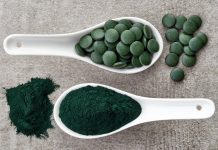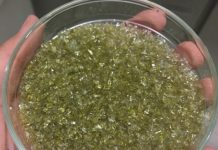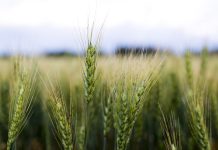Charlotte Coates, Peter G. Kevan & Saira Espinosa from the University of Guelph, explore how apivectoring is innovating agricultural systems with its method of precision biological control
The problems facing agriculture worldwide are undeniable. In recent years, the global decline in pollinator population has received a great deal of media attention. There have been many reports since the 1970s that have focused on the decline of bees due to pesticide use in agriculture [1,6]. Alongside harmful pesticide use, habitat destruction and climate change present large threats to pollinator populations. Not only do pollinators ensure that plants reproduce and, therefore, continue to produce oxygen into the atmosphere, but humans rely on pollinators to carry pollen from plant to plant to ensure that crops bear fruit. Pollinators occupy a crucial role in human food production. In many agricultural systems, managed pollinators are used to ensure a harvest. Honeybees, bumblebees, and mason bees are commonly used to pollinate a variety of fruit, vegetable, berry, and seed crops. This relationship is mutually beneficial for the pollinators and crop.
However, sometimes pollinators can also carry harmful plant pathogens from plant to plant. Given that pollinators can carry pathogenic microscopic particles, we know they can also carry beneficial microscopic particles around their environment [2]. These beneficial microscopic particles are, in fact, already being distributed around crops as part of pest management programmes as biological control agents in many agricultural systems.
Biological control agents use a living microbial antagonist of the pest/pathogen that is harming the crops to efficiently control the problem. Many biological control agents are organisms such as fungus already living in soil or the environment. Currently, most biological control agents are used in the form of a spray on a crop. Biological control agents are an increasingly popular alternative to chemical crop protectants that deteriorate ecosystem health and cause pesticide-resistant pests [2]. The public demand for agriculture to serve the needs of people and ecosystem health simultaneously is clear [6].
Apivectoring: Innovating agricultural systems
Apivectoring (entomovectoring) proposes that another way to distribute beneficial crop protectants is by using managed pollinators as vectors [2]. This system offers farmers a method of precision biological control to improve crop yields by ensuring pollination and providing non-chemical protections against crop pests. Initially tested in Canada, apivectoring has been put into practice successfully throughout North, Central and South America, Europe, Australia, New Zealand and Kenya [2]. Apivectoring has been used to prevent serious mould growth on strawberries, raspberries and blueberries. Greenhouse production of tomato and peppers have also benefitted from apivectoring against pathogen and insect pests. Oilseed crops such as sunflowers and canola have also benefitted from apivectoring’s protection against pathogenic fungi and insect pests in Europe and Canada. Successful trails using apivectoring against coffee berry borer and other diseases in coffee have been implemented in Brazil and Mexico.
In 2019, the First International Advanced Course on Using Managed Pollinators for Dissemination of Biological Control Agents for Suppression of Insect, Fungal and Other Pests of Crops was hosted at the University of Belgrade, Serbia. The course was co-sponsored by the International Commission for Plant-Pollinator Relationships (ICPPR) who have contributed greatly to the research and development of apivectoring technology.
The first step in apivectoring is to choose a biological control agent that targets the pest in question. The pests that may be controlled by apivectoring are mainly those that target the flower or fruit of a plant, as this is the location of delivery. Such pests include moulds, bacteria and insects that live in or on the flower or fruit. There are many known biological control agents in use to target each particular pest.
The biological control agents that target insect pests are known as “entomopathogens” and “fungal/bacteria inhibitors” occupy space on the plant that prevents harmful phytopathogens from establishing. Next, the biological control agent must be formulated at the correct concentration and particle size to control the pest and be easily carried by bees. To dilute the concentration of the biological agent, a vegetable-based powder such as corn flour is used. If the particle size is too small, bees may asphyxiate, and particles too large will not adhere to the bees’ bodies. Diluting entomopathogen biological agents is necessary if concentrations of the agent as provided by the manufacturer are too high and so may also infect bees [4].
Once the formulation is prepared, it is inserted into a dispenser within the bee colony. Dispensers are designed to allow bees to walk through the powdered biological control agent on the way out of the colony and enter by a separate door without any inoculum and so to prevent excess biological control agent from entering the colony. The bees exit their colony, carrying with them microscopic particles that will be deposited on any flower they visit, protecting it from specific pests constantly throughout the flowering period. This precise delivery is an efficient way to protect crops. When biological control agents are used in a spray form, a higher quantity is needed and it is not guaranteed to enter every flower.
Apivectoring provides the benefits of increased yields by producing a higher quality and quantity of crops thanks to the combined services of pollination and biological control agents [2]. This technology has been tested in field and greenhouse production. Other benefits include a reduction of biological control agent needed when compared to spray application, reduced fuel use and use of heavy machinery keeps costs for farmers low, continuous delivery of crop protection during flowering, and reduced use of water and synthetic pesticides that are known to cause pesticide-resistant populations, meaning that apivectoring technology is also economically viable [2,5].
Registration of apivectoring has begun in several countries thanks to the thorough work of researchers showing that this technology is safe for insect vectors, the environment, and human consumption [2,5]. Government input and support is needed to implement apivectoring technology and its many benefits.
There are many opportunities to expand research on apivectoring. Testing the technology on new crops as cucurbits, almonds, apples, peaches, cherries and many more is crucial. Apivectoring research has also expanded to include stingless and solitary bees and using dispensers to treat bee colonies internally for diseases and parasites. For those interested in learning more, please contact the International Organisation for Biological Control (IOBC) and the International Commission for Plant Pollinator Relations (ICPPR).
References
[1] IPBES 2016. The assessment report of the Intergovernmental Science-Policy Platform on Biodiversity and Ecosystem Services on pollinators, pollination and food production. Bonn, Germany, Secretariat of the Intergovernmental Science-Policy Platform on Biodiversity and Ecosystem Services, 556pp. https://www.ipbes.net/sites/default/files/downloads/pdf/individual_chapters_pollination_20170305.pdf
[2] Smagghe, G., Boecking, O., Maccagnani, B., Mänd, M., and Kevan P.G. (Editors) 2020. Entomovectoring for precision biocontrol and enhanced pollination of crops: exploiting synergy of ecosystem services. Springer Verlag, Switzerland.
[3] IOBC Enkegaard, A (Editor). 2005. Integrated Control in Protected Crops, Temperate Climate. IOBC wprs Bulletin. Vol 28 (1).
[4] Mommaerts, V. and Smagghe, G. 2011. Entomovectoring in plant protection. Arthropod-Plant Interactions. 5:81-95pp.
[5] Espinosa, S.S., Andrés Sánchez, A., Kevan P.G. and Figueroa, J.R. (2018). Tecnología Apivector: origen, componentes y desarrollo. CienciAgro. 2018(1): 42 -57.
[6] Kevan, P.G. and Menzel, R. 2012.The plight of pollination and the interface of neurobiology, ecology and food security. The Environmentalist. 32(3):300-310 doi 10.1007/s10669-012-9394-5
[6] Dean, R., Van Kan, J. A. L., Pretorius, Z. A., Hammond-Kosack, K. E., Di Pietro, A., Spanu, P. D.,Foster, G. D. (2012). The Top 10 fungal pathogens in molecular plant pathology. Molecular Plant Pathology, 13(4), 414–430. https://doi.org/10.1111/j.1364-3703.2011.00783.x.
Saira Espinosa Sanches is researcher in the Department of Agricultural Sciences at the National University of Colombia.
Charlotte E. R. Coates is an MSc Candidate in the School of Environmental Sciences at the University of Guelph.
Peter Kevan is University Professor Emeritus at the University of Guelph.
Please note: This is a commercial profile











